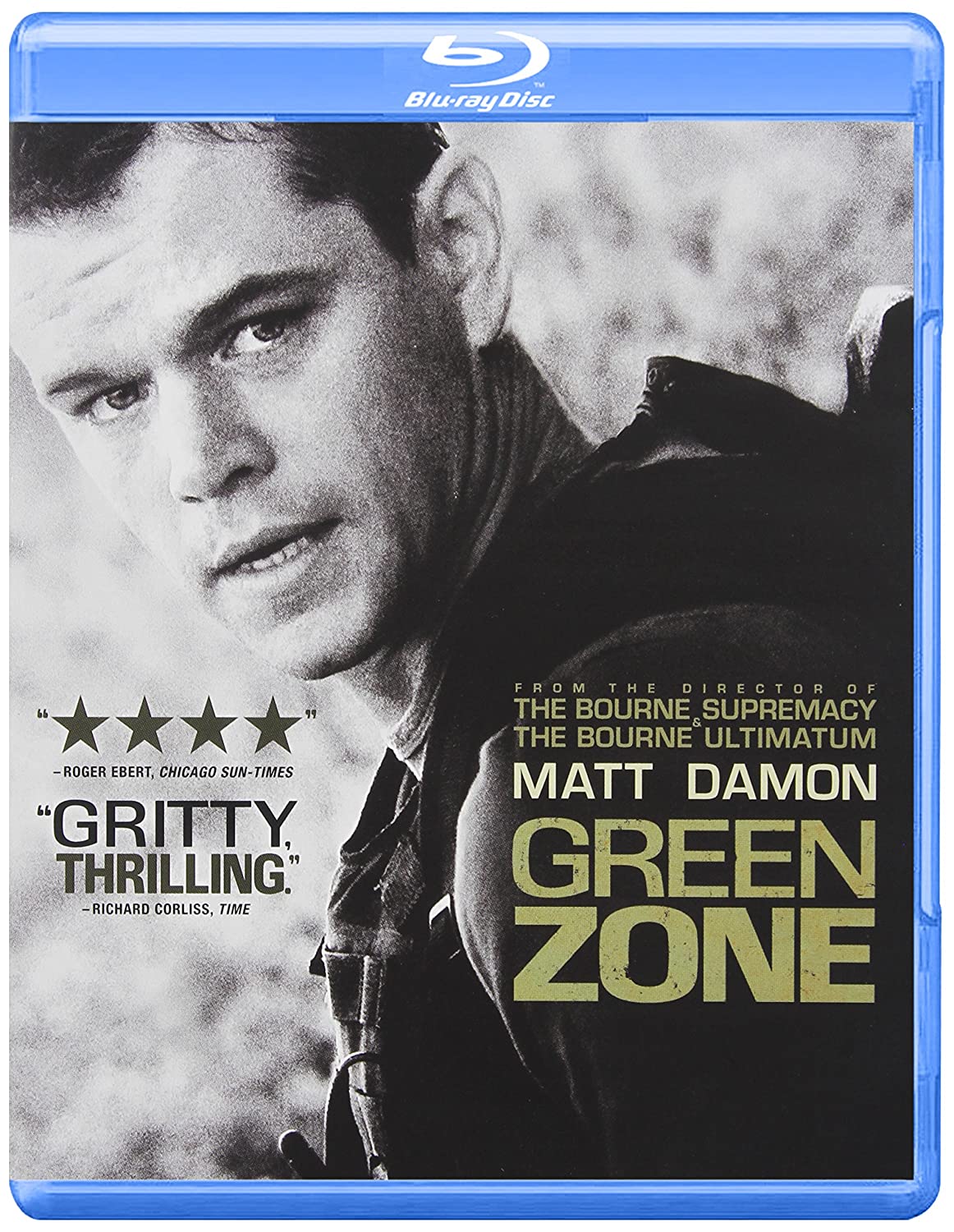
Title: Green Zone (2010)
Release Date: June 22, 2010
Format: Blu-ray Disc
Price: $14.98
On a production budget of around $100 million, but a domestic return of just over $35 million, no one would call the newest Paul Greengrass/Matt Damon collaboration, Green Zone (Universal, 2010) a hit… one might even call it a bomb (financially speaking), but this box office analysis does a disservice to a very good film that, unfortunately, serves two masters by attempting to be both an intriguing political thriller and a tough-as-nails war movie.
Worse yet, Green Zone finds itself grouped with other recent films that have centered on, or taking place during, the Iraq War. Films of that ilk typically find themselves without an audience, as if the subject was cursed. Come to think of it, the last film focused on Iraq that’s done well would probably be David O. Russell’s Three Kings, and that was about the first Iraq fun fest, not the second.
Greengrass, who previously paired up with Damon for the last two installments of the action-packed Jason Bourne Trilogy, nearly pulls off the pastiche between the two genres by carefully building up the murky political aspects of the 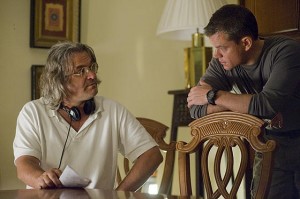

The unwitting troops on the ground in Iraq during the post-invasion fracases that led to the insurrection and broader Iraq War are also serving two masters as the film begins. On one hand there are the Neo-Conservative loyalists of the George W. Bush administration. Using misguided if not sham intelligence from dubious sources, they’ve launched a war on a sovereign nation and met success with a shock and awe campaign that utilized overwhelming force and technological superiority. As the initial military campaign drawing to a close, and prior to the insurgency and broader Iraqi War, the Bush administration assumed the rest would be a cake walk… simply a matter of winning hearts and minds away from Saddam Hussein and forming a provisional government headed by a sketchy Iranian exile (but run behind the scenes by Team Bush and the CIA, of course).
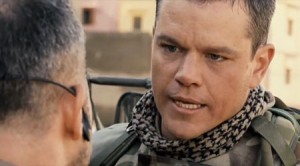

All this has now been fully documented, of course… pages from America’s tangled history of military filibustering and black operations. Pulling military resources and assets out of Afghanistan without finding Osama Bin Laden or achieving a sustainable success for the nation’s political future, leaving the Powell Doctrine for foreign wars in tatters, using the UN and Congress to justify a case for invasion just short of pushing ahead anyway, regardless of what anyone else thinks on the matter (and always the supposition that WMDs would be found and things would co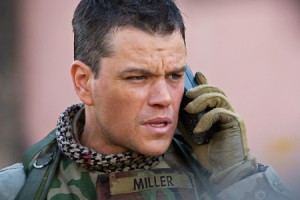

Green Zone takes place along this point in the Iraq War timeline. The film was inspired by, rather than based on, the 2006 non-fiction book, Imperial Life In the Emerald City by the Washington Post’s Rajiv Chandrasekaran. Green Zone plays as both a roman a clef about post-invasion Baghdad and a kind of whodunit where the great mystery is the lack of evidence pointing to Saddam’s alleged WMD facilities and stored weapons. As Chief Warrant Officer Roy Miller, Matt Damon does a supe

The rest of the professional cast play thinly veiled composites of real-life participants in the Iraq War drama: Greg Kinnear is pitch perfect as Clark Poundstone (based on L. Paul Bremer, Chief Administrator of the Coalition Provisional Authority), a Bush apparatchik overseeing the post-Iraq reconstruction and the regime change, and the man who would ultimately and unwittingly help spark the Iraqi insurgency; B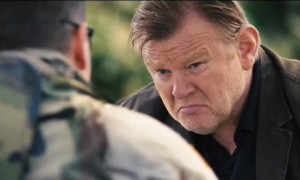

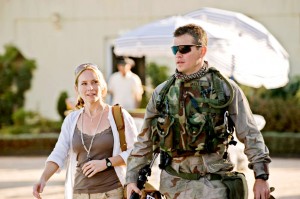



To portray the Iraqis, the filmmakers have chosen Israeli/Iraqi actor Yigal Naor to portray General Mohammed Al-Rawi (aka, the secret source of the bad intel, known by his codename “Magellan”) who we meet at the film’s start during the shock and awe bombing campaign. He thinks he understands the Americans and what they want in a post-Saddam power-structure, but he couldn’t be more wrong… A hunted man (later scenes attempting to find him through Iraq’s narrow streets and alleys easily recall the tense final reel of Carol Reed’s The Third Man), he is the “Jack of Clubs,” and the mission to find him becomes central to the film’s plot. He also comes with a convenient MacGuffin in the form of a book that holds cryptic information on all the safe-houses where Saddam’s men may be hiding… a crucial piece of evidence that everyone wants to get their hands on. 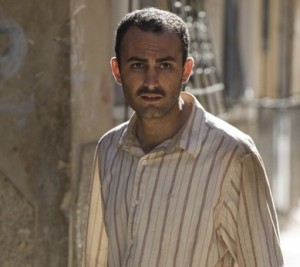

While the performances are a highlight of Green Zone, with Damon and Abdalla doing top-notch work, the other star of the show is the frenetic hand-held camera work by Barry Ackroyd, who previously worked with Greengrass on United 93 and has already done a tour in Iraq via Kathryn Bigelow’s The Hurt Locker. The hand-held technique, now so firmly entrenched in American movies that it’s sometimes strange to see a movie filmed with a locked-down camera, is appropriate to the pace Greengrass maintains throughout, but especially toward the end when chaos threatens to break during the search for Al-Rawi.
While not a particularly complex film, and hardly plot heavy for a political thriller, Green Zone does demand some attention beyond the slam-bang action set pieces, and while it’s not essential to know the true story of what went down in the Green Zone of Baghdad (Paul Bremer’s policy of de-Ba’athification is covered, as is a scene where the rival Iraqi factions argue over who will wield control and power in the new Iraq… which is very reminiscent of a similar scene in David Lean’s classic Lawrence of Arabia) it helps one to understand who’s who among the characters as well as the timeline of events. Nevertheless, the movie works purely as an intense action film if that’s all one wants from Greengrass and company. I enjoyed it, but as a political thriller based on fact, it’s no All the President’s Men nor is it as good in that regard as other more fanciful political thrillers from the past such Three Days of the Condor. Nevertheless, the film did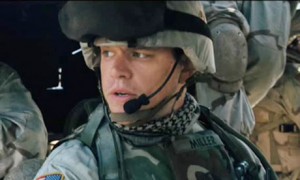

Things to notice:
- The opening sequence… shock and awesome! Greengrass puts you in the shit during the aerial bombardment and it’s stunning… both the sound and visual fury of this section are jaw-dropping, and yet, Greengrass still manages to impart vital information, set-up the film’s plot and introduce some crucial players.
- The short, sharp, shock of the sniper take-down… Nothing at all like the excruciating scenes in Kubrick’s Full Metal Jacket, yet just as brutal and disturbing (this time, superior firepower makes the take-down a LOT shorter). This is where Greengrass grabs you by the throat after that stunner of an opening sequence only to pull the rug out from under us when the WMDs these guys risked their lives for can’t be found… just empty warehouses and rusty, old equipment.
- The fact that the film was shot in Spain and Morocco, but looks for all the world like the Baghdad seen repeatedly on 24-hours news networks. The digital art necessary to bring Baghdad to life is extraordinary and seamless. We get some amazing flyover establishing shots that you’d swear were really filmed on location in the Green Zone itself… the iconic Swords of Qādisīyah (Hands of Victory) are there, the Republican Palace, mosques and other architectural landmarks are there and all are well-represented and photo-realistic whether in bright sunlight or murky darkness.
- Damon’s key scene during the WMD briefing where he claims all his guys did was “roll a donut” on finding actual weapons or traces of them regardless of where the intel has them look. Damon projects a commanding and intelligent demeanor, but knows when to back off from being respectfully skeptical when his commanding officers take him down a notch. Damon handles the transition well, allowing us to gain both information and sympathize with his character as we start going down the rabbit hole with him.
- The Green Zone itself… Well represented in set design flourishes (check out the “Saddam the Warrior” heads atop the palace. A CGI trick or actual set design, you be the judge), the production design is top-notch and lends complete realism to every sequence.
- Another design standout is the laid-back atmosphere at the Al-Rashid hotel. The scene when Miller’s troops visit the hotel while he goes searching for Marty Brown is a virtual oasis amidst the Baghdad wasteland. It’s a study in contrasts… while troops are getting their asses shot off, the hoi polloi of CIA personnel, neo-cons and journalists are living it up poolside with Domino’s pizza, beer and a bevy of lovely, bathing-suit clad beauties. This scene reminds me of a similar, but more humorous, one in Oliver Stone’s Salvador when James Wood’s sleazy photojournalist attempts to glean information from the same type of characters living it up in relative safety with the comforts of home while those they seek to protect face a wretched, uncertain future.
- Bush’s infamous “Mission Accomplished” speech on TV playing in the background… a small jab perhaps, but one the filmmakers have kept in the background of one scene. Take from it what you will, is all Greengrass is saying here. The man refuses to beat his audience over the head with the message. Nicely done.
- Damon’s easy approach to military jargon and language… he seems rooted in reality and not just the film’s reality. Also, Greengrass’s wise choice in using actual Iraq vets for supporting characters and extras. The authenticity of certain scenes (the sniper quickly being taken toward at the beginning of the film, their interrogations of the local Iraqis, the way they confront Miller over some of his decisions) is due to these non-pros and their first-hand experiences.
- The violence in the film is quick and ugly but rarely dwelt upon for longer than need be. Rather, I found myself growing uncomfortable from actual suspense during moments when information must be negotiated via interrogation. Some of the violence stems from cultural confusion, and the feeling is very authentic… certainly gets the heart going.
- The score by John Powell is a percussive, string-based work that keeps the pulse pounding, ratcheting up the excitement without being bombastic or overdone… it’s a great piece of work for this particular film.
The film is worth seeing, no doubt about it… give it a chance, regardless of how you feel about the Iraq war or Iraq war movies and I doubt you’ll be disappointed.
That said, the Blu-ray is a strong release by Universal, considering it could have easily been dumped, with a gorgeous AVC MPEG-4 transfer in 1080p/2.40:1 widescreen. The thing is, you may have trouble realizing how great it looks because of the quasi-documentary style that Greengrass and Ackroyd use to tell the story. I’m finding this to be the case with many Blu-ray releases where the filmmakers appropriated a style that mixes film and digital video, or has been toyed with in post. Whether a film like Natural Born Killers (at the extreme) or Traffic or Green Zone, it’s getting hard to tell if there are issues with the BD when the filmmaker’s purposefully use shots filmed with heavy grain stock or grain due to lighting 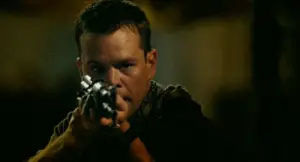

Where the BD really comes through is on sound. I’d expect nothing less for a film like this, and that opening shock and awe sequences is so ear-shattering impressive that you’ll feel it in your bones (the disc is enabled for D-Box, so those of you with the jiggly Barcaloungers can really experience that Sensurround effect). The DTS-HD MA 5.1 mix in English (DTS 5.1 for French and Spanish) uses the multi-channel and LFE so well you feel as if your house will break into pieces and come raining down on you. Dialogue is clear, but sometimes the music does overshadow things during the chase scenes at the end, drowning out some ambient effects. Overall, it’s a terrific audio experience, and one reason to snap the Blu-ray up for your home theater library. While Greengrass gives the film a visually immersive feel, the audio mix compliments it with a feeling of being dropped into utter chaos… it’s frighteningly effective.
Subtitles are in English SDH, French and Spanish, and there is a descriptive audio track as well.
Universal did not scrimp on extras for the disc, no matter how well it did in theaters, and that’s appropriate considering the powerhouse talent involved. Still, it’s quite meager compared to other BD’s recently released, but I suppose just perfect enough for this release.
First some criticism that has nothing to do with the film itself or the transfer:
From the opening Universal logo you’ll get a barrage of ads (aka trailers, though one is for the PocketBlu mobile feature). The minute the disc resolves itself in the player, they begin in earnest. You can skip over ‘em, but it takes a while and is 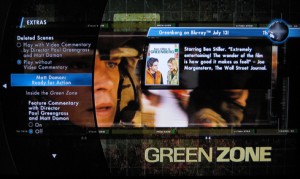

The other petty annoyance is the incre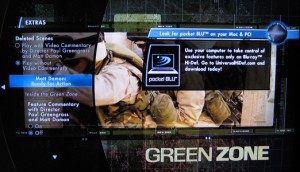

Now on to the goodies… including a pretty terrific audio commentary track with Paul Greengrass and Matt Damon that demonstrates their affinity for each other as artists and actually ads value to the film. We get to know their motivations for making the film, their experiences along the way, and their own feelings on the film’s politics and real-life wartime events. Definitely worth a listen.
Deleted scenes are offered with a video commentary by Damon, Greengrass and Kit Greengrass, Paul’s young son. Essentially, they’re watching the various deleted scenes (or, as Damon deadpans, “scenes that your Dad screwed up, kid.”)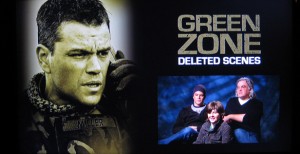

- Met D Dig For WMD at Tikrit University — a short scene showing another waste of time and resources in order to find old paint cans amidst an extensive excavation. No WMDs here, move along, move along.
- Mukhabarat Headquarters — A heavy scene where Iraqis are show going through Ba’athist government files and Zubaidi (the Ahmed Chalabi composite) gets a tour of torture chambers courtesy of Poundstone. Suddenly, Miller’s group rolls into the area and witnesses the looting of files (that may hold possible clues to WMDs) and quickly find themselves in a short skirmish that gets them a good ass-kicking by a commanding officer and Poundstone.
- Mosque Explosion and Returning Hamza’s Body — The final prayers are intoned as members of Saddam’s old guard complete their rites and head out of a mosque only to be killed when a car bomb explodes. After catching and losing (to American Special Forces) one Ayad Hamza, a subordinate of Al-Rawi’s, Miller and Freddie make a mad dash to find him, but too late… Soon they must bring Hamza’s body to his widow in a tempestuous scene that critiques the cultural class divisions of the newly deposed Iraqi elite and give Miller further clues into his own government’s duplicity and false-flag motivations.
- Poundstone and Zubaidi Discuss the Plan — Featuring an establishing shot of the terrific set design that truly makes it feel like post-invasion Baghdad, this scene quickly moves to a Godfather-esque dark meeting room where Poundstone keeps Zubaidi in line with promises of support for his political future, as well as plans for rebuilding according to US wants and needs (mainly oil).
U-Control Special Features:
With U-Control, you’ll get a choice of either video commentary with Greengrass and Damon or an elaborate PnP that 

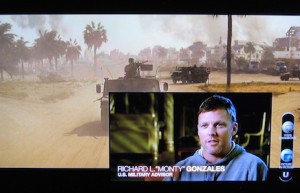

Other Special Features:
Matt Damon: Ready for Action: Though it sounds like something out of Boogie Nights this featurette (with content that can be glimpsed during the PnP U-Control feature) relates how Damon worked, interacted and commanded his team of non-pro vets, in turn becoming their Chief and gaining their respect. We also get an understanding of his commitment to authenticity and his collaboration with his fellow actors when he discusses the basis for his character as well as his quest to create a realistic, sympathetic portrayal of a military professional coming to terms with the shenanigans of the Bush loyalists and an inept intelligence agency.
Inside the Green Zone: An EPK carved from the more extensive PnP feature that covers the production in summary fashion. Most of this is good stuff, but if you’ve seen the movie, you don’t need to be sold on it after-the-fact. Damon and Greengrass do have a cute mutual appreciation society thing going on, and you can tell they truly enjoy working with each other… and will probably continue to do so.
What Else?
- What’s New: BD-Live Trailers
- How-to Blu-ray User Guide
- My Scenes Bookmarks
- Digital Copy (disc) for use on computers and mobile devices
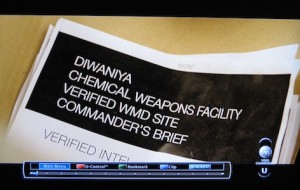


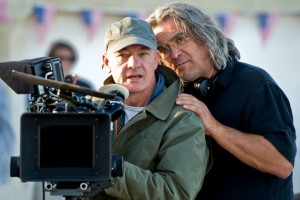
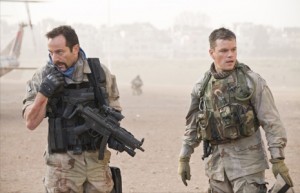

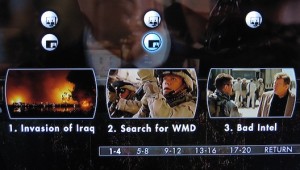
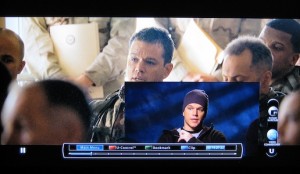
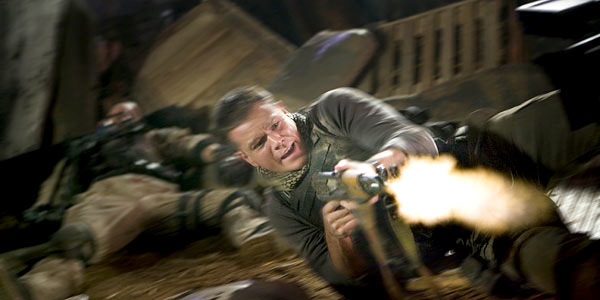

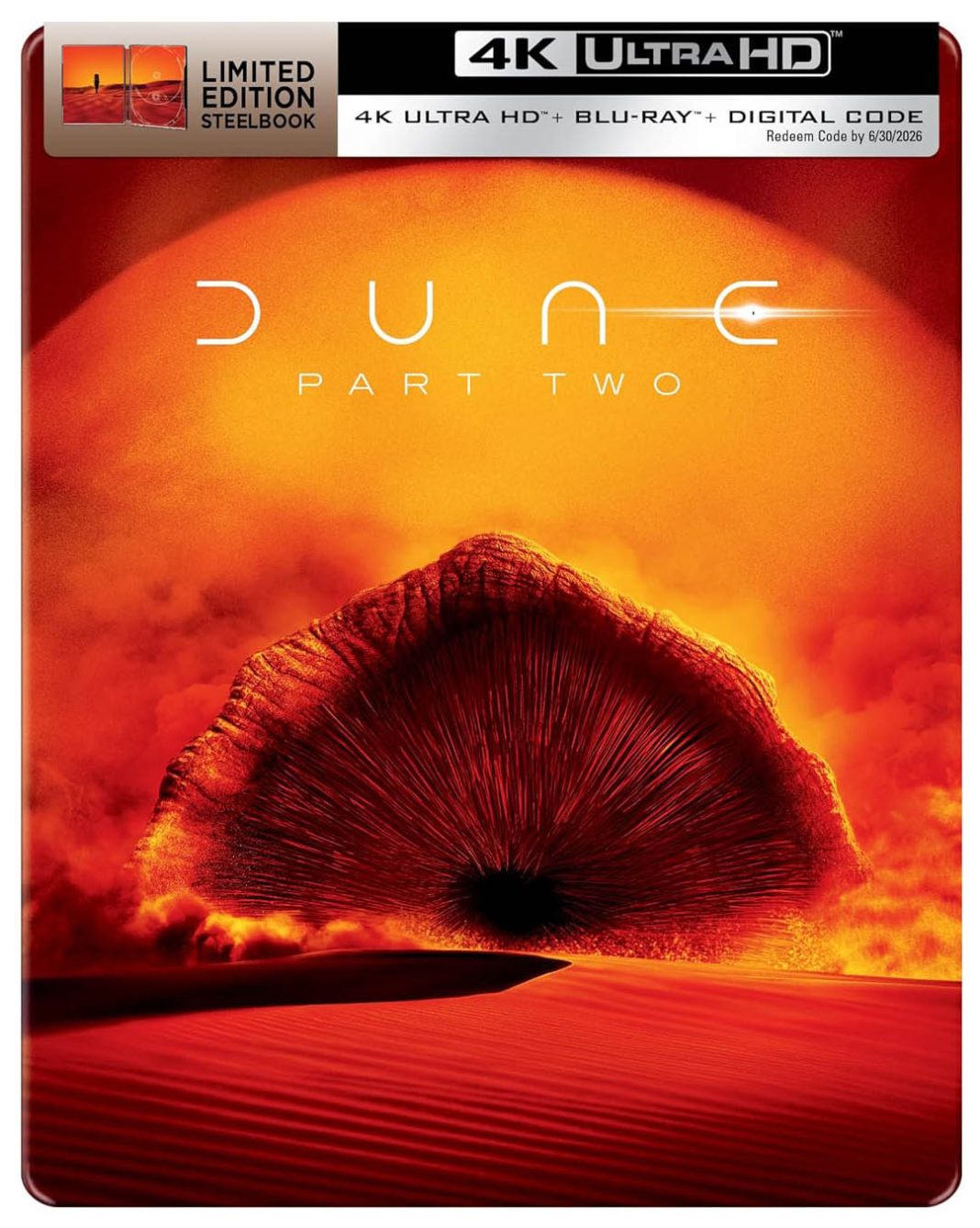

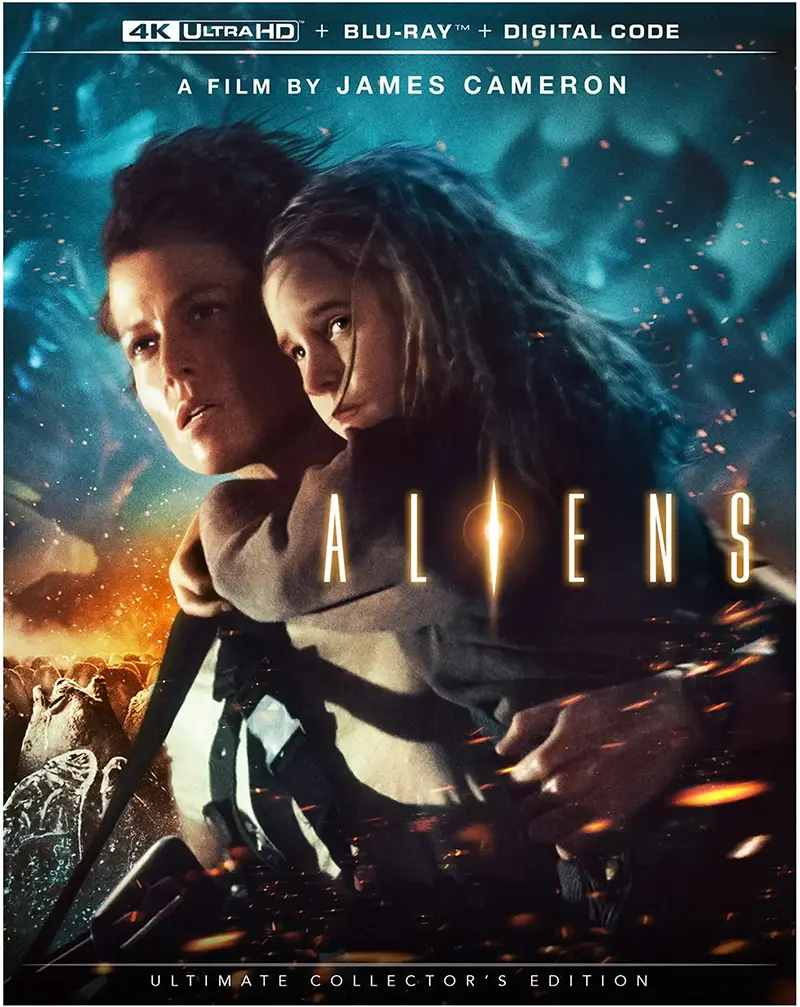






[…] Blu-ray Review: Green ZoneHD-ReportOne flyover in particular uses lens flare in a way that just made me wanna weep it was so gracefully done… and that looked terrific on Blu-ray. …and more » […]
I throughly enjoy your insights and critiques on Blu-ray movies. I find them to be spot on. I enjoyed this film, and after reading your recommendation, went back and watched again…through your eyes..so to speak, and I agree with you. Keep up the good work.